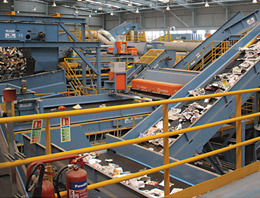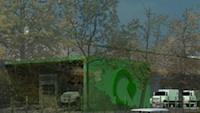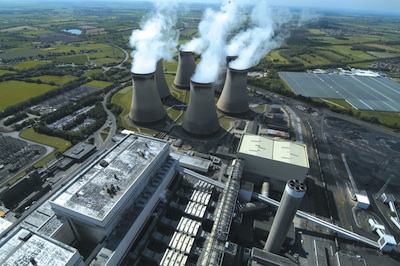
Uncategorised (4996)
For example, in a recent letter to The Times, London mayor Boris Johnson promised to ‘leave no stone unturned or unfracked’ if shale gas is found in London.
In a statement on his company's website, though, David Symons, director at consultancy WSP – a firm with significant international shale experience – responded by suggesting that Johnson was getting a bit carried away:
"Although oil has been found in many areas across southern England – from the Weald basin to even some small finds in north London - the reality is that shale gas is a new science and there’s still considerably uncertainty on where the resources are and whether they are economically viable to extract, " said Symons.
“Rather than big sweeping statements the Mayor could do much better to focus on the elements in the 2020 Vision that are in his control, such as making London a leader in energy efficiency."
Fair comment, I suppose, but the Mayor's robust stand does make a welcome departure from the unfounded scare stories about shale, which are still being peddled by many politicians, scientists and journalists.

Schenck Process UK, based in Doncaster, has recently secured an order for the supply of new technology for the conveying of biomass material at the UK’s largest biomass conversion project which is underway at Drax Power Station in North Yorkshire.
The company's pneumatic conveying system will play a role in the project that will see Drax convert three of its six generating units to burn sustainable biomass in place of coal.
The Drax biomass storage and handling project includes the use of individual conveying and mill feeding systems, with each conveying vessel having multiple Clyde Process Dome Valves from Clyde Process Ltd – part of Schenck Process Ltd.
This specialised valve was selected for its reliability and is designed to operate up to one million times without the need for maintenance, according to a statement from Schenck Process.
To avoid unnecessary generation downtime during the construction phase of the project, the Schenck Process solution factors in considerations such as the location of the new day silos and conveyors in relation to existing infrastructure thus ensuring minimal disruption to power generation.
Schenck Process said it has worked closely with Shepherd Construction, the main contractor for the project, to ensure that the silo storage, and its associated conveying system, interfaces smoothly with the new conveying equipment.

PM Shotton, one of the UK’s largest recyclers of used newsprint and magazines, has installed a complete dust extraction plant, from Dust Control Systems Ltd, at its new £17-million materials recovery facility (MRF) in North Wales.
Located at the site of the Finish-owned company’s UPM Shotton paper mill, the 250ktpa facility is designed to sort mixed recyclables from kerbside collections such as plastic bottles, cardboard, newspapers and metals.
Around 120kt will be newspapers and magazines, which will provide 20% of the recovered paper used as raw material in the mill’s paper production.
DCS Ltd was contracted to provide a complete turn-key package, including design, supply, installation and commissioning of a material stream dust control system serving drum feeders, sort conveyors, optical sorters and screens.
The DCS installation comprises an externally located filter unit, strategically-sited extraction hoods, interconnecting ductwork and a briquetting press.
The ATEX compliant filter is a high-efficiency Schuko EcoVar 04 series 2030 modular unit, which has a filter surface area of 677m2, and a total airflow capacity of 60,000m3/hr.
The filter is fitted with tubular filter elements designed for duty on fibrous dusts, and its 75kW fanset provides 24/7 extraction. Collected dust waste is discharged pressure-free from the filter hoppers, via a heavy-duty conveyor and rotary valve, directly into a pre-receiving briquetting hopper.
Extracted dust is then screw fed to the briquettor which is capable of pressing up to 100kg of extracted dust per hour to form 60mm diameter briquettes to be used as boiler feed. Return air ductwork is provided to allow warm cleaned air to be returned to the building in winter and discharged to atmosphere in summer by the manual operation of summer/winter dampers.
Variable speed technology is employed to control and vary fan speed should there be a need to increase or decrease extraction efficiency to different areas of the plant. Air volumes are automatically adjusted when manually operated dampers are closed and re-opened.
DCS worked very closely with UPM Shotton throughout the specification, supply and installation process, and also with Machinex who supplied and installed the recycling plant, said John Barker of DCS Ltd.
"UPM required clearly defined activity schedules to match their own building programme," he said. The contract also included final warranty tests based on HSG 258 (Control of Airborne Contaminates at Work) plus visual tests which were carried out using a high intensity light beam.
(Image source: DCS)
While most in the process sector have welcomed the UK government's belated backing for shale gas, some engineers now see a need to manage expectations of some of the more enthusiastic converts.
For example, in a recent letter to The Times, London mayor Boris Johnson promised to ‘leave no stone unturned or unfracked’ if shale gas is found in London.
In response, though, David Symons, director at consultancy WSP, which has international shale experience, suggested that Boris was getting a bit carried away with the shale fever:
"Although oil has been found in many areas across southern England – from the Weald basin to even some small finds in north London - the reality is that shale gas is a new science and there’s still considerably uncertainty on where the resources are and whether they are economically viable to extract, " said Symons.
“Rather than big sweeping statements the Mayor could do much better to focus on the elements in the 2020 Vision that are in his control, such as making London a leader in energy efficiency."
"The Vision, quite rightly, commits to retrofitting every badly insulated home in the city – as a way to save energy and be ‘a formidable creator of employment.’
Making London the leader in energy efficiency is far more practical and far more deliverable than big rhetoric which inspires passion but little else.”
Fair comment, I suppose, but the question still remains about how cities like London set about tapping into shale and other energy resources – especially given all the uncertainties over power supply in the years ahead.

Energos has been appointed as technology provider for a thermal conversion facility, as part of AmeyCespa's proposed Milton Keynes waste recovery park.
The proposed project involves a three-stage waste treatment process to treat household waste, using mechanical treatment to sort recyclates, anaerobic digestion and thermal treatment. Start up is scheduled for 2016, subject to the project gaining planning consent.
UK-based Energos' technology would be used at the final process stage to convert any remaining, non-recyclable waste into a syngas. This would be used to produce high-temperature steam that can then be converted into electricity in a turbine.
According to Energos, the facility would be able to process more than 90,000 tonnes of non-recyclable waste and could generate 7MW of electricity.
(Image credit: Race Cottam Associates Ltd)

The European Commission, EU Member States and European industry will invest more than €22 billion over the next seven years under a new innovation plan announced by the EC 10 July.
According to the Commission, most of the investment will go to five public-private partnerships (PPPs) in innovative medicines, aeronautics, bio-based industries, fuel cells and hydrogen, and electronics (see below).
Overall, a proposed €8 billion investment from the next EU research and innovation programme, Horizon 2020, will secure around €10 billion from industry, and close to €4 billion from EU Member States, said an EC statement.
Several of the announced PPPs put emphasis on chemical sector innovations and include new processes, increased use of renewable feedstock, recycling and re-use.
Some will leverage existing programmes including Cefic PPPs (BRIDGE (Bio-based and Renewable Industries for Development and Growth in Europe) and SPIRE (Sustainable Process Industry) which that have strategic research and innovation roadmaps and are ready to start.
SPIRE, for instance, is a Cefic flagship initiative to bring together innovative companies from eight industrial process industry sectors committed to innovate not only within their current frames but also to explore synergies between them.
The SPIRE PPP covers areas such as energy use, water, renewable feedstock and process optimisation that are essential for efficiency and competitiveness, according to the industry group.
“The Commission initiative is a major step forward sending a clear positive signal for the process industries to establish innovative approaches that will spur European competitiveness," Gernot Klotz, Cefic executive director for research and innovation.
“These new PPPs set as top priority the need to cross ‘the valley of death’ from research to the marketed solutions our society needs. We must jointly act fast and efficiently to face the challenges of global competition and sustainability goals.”
The five PPPs – called joint technology initiatives (JTIs) – are:
- Innovative Medicines 2 (IMI2): to develop next generation vaccines, medicines and treatments;
- Fuel Cells and Hydrogen 2 (FCH2): to expand the use of clean and efficient technologies in transport, industry and energy;
- Clean Sky 2 (CS2): to develop cleaner, quieter aircraft with significantly less CO2 emissions;
- Bio-based Industries (BBI): to use renewable natural resources and innovative technologies for greener everyday products;
- Electronic Components and Systems (ECSEL): to boost Europe’s electronics manufacturing capabilities.

Independent chemicals maker Thomas Swan & Co. Ltd is seeking local approvals to establish an anaerobic digestion (AD) plant on its site in partnership with Hallwick Energy.
Under the plan, Hallwick is to lease land from Consett, County Durham-based Thomas Swan, build and run the plant and sell the energy to the company. Any surplus is to be fed into the national grid.
The AD plant would give Thomas Swan the opportunity to use power which is sustainably produced and less susceptible to ever rising prices, explains Harry Swan, managing director of the company.
"The cost of power is a huge problem for many companies in the UK. We are committed to using renewable energy which is reliable and makes us self-sufficient – reducing our overheads, protecting existing jobs and hopefully, creating new ones," said Swan.
In May 2012, Bridgnorth, Shropshire-based Hallwick Energy announced the start-up of its first AD project. The unit, on a farm near Buntingford in Hertfordshire, was installed to export electricity to the national grid.
This was followed a month later by the company's commissioning of a second 1Mw AD plant. The site, near Dunstable in Bedfordshire was being run on farm-based crops and crop residues as well as some grass silage from nearby Luton Airport.
(image source: Thomas Swan)

Capula is to provide the control and automation systems for the new boiler distribution system at Drax Power Station. The award was made by contractor Shepherd Engineering Services (SES)
Drax is installing new receipt, storage and distribution systems are being constructed at its Yorkshire coal-fired power station to help switch to a predominantly biomass-fuelled operation.
Capula was recently been awarded a contract by SES for the provision of the control and automation systems for the new biomass storage facility at Drax Power Station.
The firm will be providing a Schneider-based control solution for the boiler distribution system, which consists of two sections: the common systems and unitised systems.
The common systems will deal with the reception of fuel from storage. The unitised systems will control the eventual transport of the fuel to the boilers of the three converted generating units.

Tamar Energy has signed up Clarke Energy of Liverpool, UK, to supply combined heat and power systems for four anaerobic digestion projects in the UK.
The order is for six biogas engines with a total renewable power output of 8MWe to Tamar Energy’s anaerobic digestion plants at: Holbeach, Lincolnshire – 1 x J420, total electrical output 1.5MW; Retford, Yorkshire – 2 x J420 (3.0MW); Farleigh, Wiltshire – 1 x J420 (1.5MW); and Halstead, Essex – 2 x J416 (2.2MW).
The four of GE Power & Water’s J420 and two J416 containerised Jenbacher gas engines are fitted with heat exchangers to facilitate cogeneration, recovering heat as hot water for use in the heating of the digesters and pasteurisation.
The projects are part of Tamar Energy's long-term aim of building a UK network of 40 plants and producing 100MW of renewable base-load electricity. UK government agencies aim to support the establishment of up to 3-5 Terawatt hours of electricity from anaerobic digestion by 2020.
"Clarke Energy’s technical solution, backed up by the largest network of dedicated gas engine specialists in the UK, were key factors in us awarding these orders," said Dan Poulson, engineering and strategy director of Tamar Energy.
Egdon Resources plc has received planning approval from North Lincolnshire Council to drill an exploratory borehole on Licence PEDL 180 targeting the Wressle prospect in onshore UK in the second half of 2013.
Egdon Resources has a 25% stake in the block and is the operator. The other partners are: Europa Oil & Gas, which has a 33.34% working interest in the block, alongside Celtique Energie Petroleum Ltd (33.33%); and Union Jack Oil plc (8.33%).
PEDL180 covers an area of 100 km2 on the western margin of the Humber Basin in the East Midlands Petroleum Province. The Wressle-1 well will target the highly petroliferous Brigg Broughton anticline trending WNW through PEDLs 180, 182 and 241.
Several oil discoveries have been made along this trend at Brigg, Broughton and Glanford and it also includes the Crosby Warren oil field operated by Europa. The operator estimates Wressle holds mean gross unrisked prospective resources of 2.1 million barrels of oil.
Drilling operations at Wressle are expected to commence in the second half of 2013. The well is targeting multiple prospective sandstone reservoirs in a structurally favourable position near the crest of the Wressle structure within the Upper Carboniferous and will be drilled as a deviated well to a total depth of about 2,300 metres with a maximum offset of approximately 1,250 metres.
"Wressle-1 is the first of up to five wells to be drilled across our asset base over the next eighteen months, each of which has the potential to transform our existing production profile and reserves," said Europa's CEO Hugh Mackay.
With mean gross un-risked prospective resources of 2. 1 mmbo, Wressle is small compared to our Mullen and Kiernan prospects in the South Porcupine Basin, offshore Ireland, and Berenx, the deep gas appraisal project in onshore France.
However, said Mackay, drilling success at Wressle "would generate considerable near term cash flow that we would reinvest into proving up and monetising other highly prospective exploration and appraisal projects in our portfolio."
More...
Process Industry Match (PIM) addresses the need for better dialogue and communication between investors, engineering firms, specifiers, integrators, suppliers and end users in the industrial process sector – internationally.
To achieve this, the PIM Website and Newsletter majors on developments that enhance the performance of process facilities. There is, therefore, a particular focus on investment, engineering & construction and plant upgrade activities, as well as on new operational and maintenance programmes.
The editorial spans the key verticals – chemicals, energy, food & drink, life sciences, materials, oil & gas, pulp & paper and water – and technologies, including control & automation, instrumentation, field comms, pumps, valves, compressors, mixing, heat transfer and solids handling.
Welcome to our website. If you continue to browse and use this website you are agreeing to comply with and be bound by the following terms and conditions of use, which together with our privacy policy govern Process Industry Match’s relationship with you in relation to this website.
The term “Process Industry Match” or “us” or “we” refers to the owner of the website. The term “you” refers to the user or viewer of our website.
The use of this website is subject to the following terms of use:
- The content of the pages of this website is for your general information and use only. It is subject to change without notice.
- Neither we nor any third parties provide any warranty or guarantee as to the accuracy, timeliness, performance, completeness or suitability of the information and materials found or offered on this website for any particular purpose. You acknowledge that such information and materials may contain inaccuracies or errors and we expressly exclude liability for any such inaccuracies or errors to the fullest extent permitted by law.
- Your use of any information or materials on this website is entirely at your own risk, for which we shall not be liable. It shall be your own responsibility to ensure that any products, services or information available through this website meet your specific requirements.
- This website contains material which is owned by or licensed to us. This material includes, but is not limited to, the design, layout, look, appearance and graphics. Reproduction is prohibited other than in accordance with the copyright notice, which forms part of these terms and conditions.
- All trademarks reproduced in this website, which are not the property of, or licensed to the operator, are acknowledged on the website.
- Unauthorised use of this website may give to a claim for damages and/or be a criminal offence.
- From time to time this website may also include links to other websites. These links are provided for your convenience to provide further information. They do not signify that we endorse the website(s). We have no responsibility for the content of the linked website(s).
- You may not create a link to this website from another website or document without Process Industry Match’s prior written consent.
- Your use of this website and any dispute arising out of such use of the website is subject to the laws of England and Wales.
